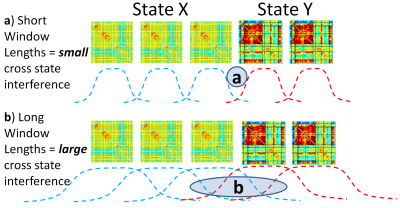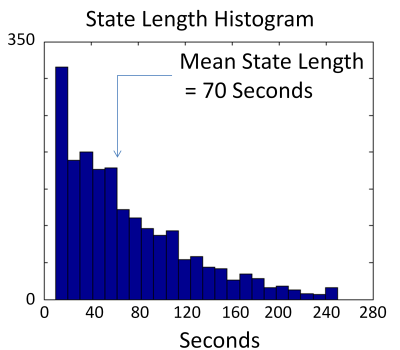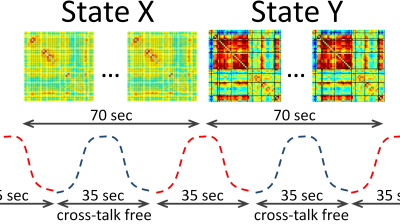2415
Cross State Interference in Dynamic Functional ConnectivityVictor D. Vergara1 and Vince D. Calhoun1
1The Mind Research Network, Albuquerque, NM, United States
Synopsis
Several parameters need to be set in a dynamic connectivity analysis. The window length (time interval used to estimate windowed correlation) gained recent attention after simulated data showed that a minimum length should be observed. This work presents evidence that large window lengths are not free of nuisances and proposes a method to find an appropriate window length. The proposed length is found to be half the average duration of a dynamic connectivity state. Longer window lengths produces cross-talk interference among states.
Introduction
One of the most utilized estimations of functional connectivity is based on temporal correlation. While static connectivity is typically estimated using temporal spans of five minutes or longer (Allen et al., 2011), dynamic connectivity utilizes time intervals (known as window length) close to a minute or less (Hutchison et al., 2013). A recent hypothesis suggested against the use of shorter intervals (Leonardi & Van De Ville, 2015) using idealized simulations. A later study suggested that real data could allow window lengths close to 40 seconds (Zalesky & Breakspear, 2015). In this work we present hypothesis and empirical evidence indicating that using long intervals may cause cross-talk interference among dynamic functional network connectivity (dFNC) states. Figure 1 illustrates the reasoning behind the cross-talk interference. In biomarker assessment, the interference might result in poorer differentiation between patients and controls.Methods
The functional magnetic resonance imaging (fMRI) data comes from a previously utilized set of 96 subjects with matched sex and age (up to 3 years): 47 with mild traumatic brain injury (mTBI) and 47 healthy controls (Vergara, Mayer, Damaraju, Kiehl, & Calhoun, 2017). Three standard dFNC analyses (Allen et al., 2014) were performed using the GIFT software (http://mialab.mrn.org/software/gift/) with window lengths of 10, 30 and 60 seconds. Classification algorithms based on linear support vector machines (lSVM) with leave-one-out cross validation were applied on each analysis replicating the methodology utilized in (Vergara, Mayer, Damaraju, & Calhoun, 2017). To test cross-talk we estimated the covariance among states to test if larger window sizes show increased cross state interference.Results
The elbow criteria applied to cluster validity indexes (Allen et al., 2014) of each of the three window lengths showed that four dFNC states suffice to represent the dynamic connectivity. After applying the lSVM classification to each state and dFNC analysis we found one state with an accuracy over 70% while the other states had accuracies below 60%. Pair-wise covariance was calculated for each pair of states and for each subject. ANOVA tests were performed on each covariance identifying a clear difference between the two small window lengths (10 and 30 seconds) and the longest 60 second window length. Boxplots for covariance tests are displayed in Figure 3. Finally, state length measured as the number of seconds between state transitions (temporal interval between the beginning and the end of each state) was performed and the histogram displayed in Figure 4.Discussion
Numeric results indicate a clear difference when transitioning from small (30 seconds) to large (60 seconds) window lengths. This showed differences in the two assessed characteristics: cross-talk interference and classification accuracy. Before interpreting these observations, notice that lSVM results were high only in one dFNC state (State 2) while the other states were less useful for classification. We speculate that an appropriate isolation of State 2 from nuisance signals might be necessary to achieve high classification performance. Following the same train of thought presented in Figure 1, the source of such nuisances could be attributed to the cross-talk between other dFNC states and State 2. This hypothesis is supported by the increase in covariance among states associated to window length presented in Figure 3. By including the mean state length (MSL) of 70 seconds in our digression (see Figure 4), we can see that half the MSL (½MSL = 35 second) is very close to the point where cross-talk seems to affect classification results. We explain this by noticing that at ½MSL there is, in a mean sense, at least one cross-talk free window correlation as illustrated in Figure 5.Conclusion
Critiques on the selection of dFNC window lengths had described problems associated with selecting small time intervals (Leonardi & Van De Ville, 2015). By analyzing real data, this work presented evidence that going for larger window lengths also has caveats. For practical purposes, we suggest that dFNC window length shall be chosen as ½MSL. This selection does not guarantee cross-talk free analysis since state lengths smaller than the mean will suffer from this nuisance. However, presented evidence from real data suggests this selection, based on mean value argumentations, is a good trade-off between small and large window lengths.Acknowledgements
This work was supported by grants from the National Institutes of Health grant numbers 2R01EB005846, R01REB020407 and P20GM103472 to V.D.C.; R01AA012238 and R01DA030344 to K.H and National Science Foundation grants NSF grants 1539067/1631819 to V.D.C. The author(s) declare that there were no other sources of financial support or compensation that could be perceived as constituting a potential conflict of interest.References
Allen, E. A., Damaraju, E., Plis, S. M., Erhardt, E. B., Eichele, T., & Calhoun, V. D. (2014). Tracking whole-brain connectivity dynamics in the resting state. Cereb Cortex, 24(3), 663-676. doi:10.1093/cercor/bhs352 Allen, E. A., Erhardt, E. B., Damaraju, E., Gruner, W., Segall, J. M., Silva, R. F., . . . Calhoun, V. D. (2011). A baseline for the multivariate comparison of resting-state networks. Front Syst Neurosci, 5, 2. doi:10.3389/fnsys.2011.00002 Hutchison, R. M., Womelsdorf, T., Allen, E. A., Bandettini, P. A., Calhoun, V. D., Corbetta, M., . . . Gonzalez-Castillo, J. (2013). Dynamic functional connectivity: promise, issues, and interpretations. Neuroimage, 80, 360-378. Leonardi, N., & Van De Ville, D. (2015). On spurious and real fluctuations of dynamic functional connectivity during rest. Neuroimage, 104, 430-436. doi:10.1016/j.neuroimage.2014.09.007 Vergara, V. M., Mayer, A. R., Damaraju, E., & Calhoun, V. D. (2017). The effect of preprocessing in dynamic functional network connectivity used to classify mild traumatic brain injury. Brain Behav, 7(10), e00809. doi:10.1002/brb3.809 Vergara, V. M., Mayer, A. R., Damaraju, E., Kiehl, K. A., & Calhoun, V. (2017). Detection of Mild Traumatic Brain Injury by Machine Learning Classification Using Resting State Functional Network Connectivity and Fractional Anisotropy. J Neurotrauma, 34(5), 1045-1053. doi:10.1089/neu.2016.4526 Zalesky, A., & Breakspear, M. (2015). Towards a statistical test for functional connectivity dynamics. Neuroimage, 114, 466-470. doi:10.1016/j.neuroimage.2015.03.047Figures

Figure 1. Cross-talk State Interference
Hypothesis.

Figure 2. Classification Results for
dFNC State 2.
Accuracy for State 1, State 3, and State 4 were poor and below 60 %.

Figure 3. Boxplots for
Covariance among States.
An ANOVA was performed for each boxplot. The p-values
correspond to these ANOVAs.

Figure 4. State Length Histogram. Obtained after
assessing the starting and ending points of each dFNC state in their temporal
succession.

Figure 5. Cross-talk Free Window at Half the Mean State
Length. If the mean state
length (MSL) is 70 seconds. Selecting a window length of half the MSL can
produce enough cross-talk free windows in the average